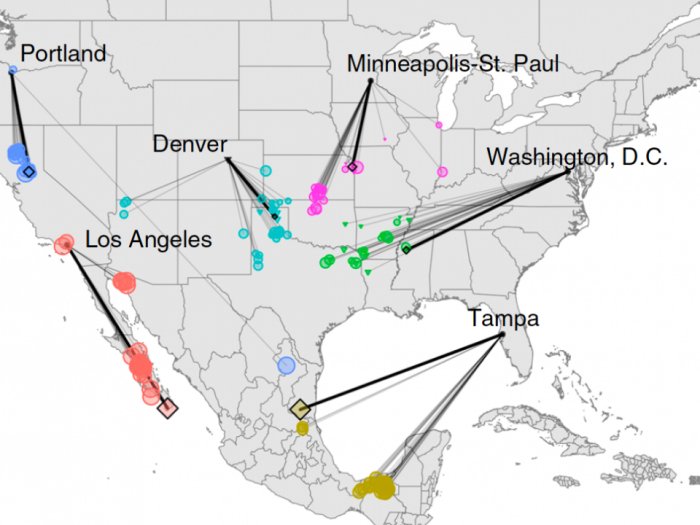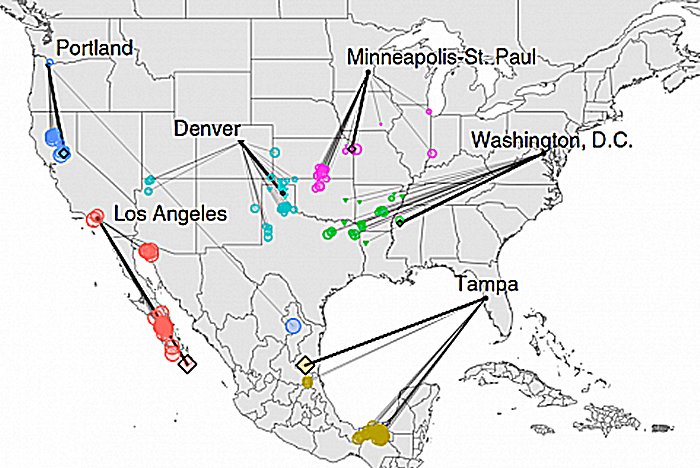MessageToEagle.com – Climate of North American cities will shift hundreds miles in one generation, researchers say.
Significant climate changes will be visible in 540 North American cities.
The study found that by the 2080s, even if limits are placed on emissions, the climate of North American urban areas will feel substantially different, and in many cases completely unlike contemporary climates found anywhere in the western hemisphere north of the equator.

If emissions continue unabated throughout the 21st century, the climate of North American urban areas will become, on average, most like the contemporary climate of locations about 500 miles away and mainly to the south. This means the average urban dweller is going to have to drive more than 500 miles to the south to find a climate similar to their home city by 2080.
In the eastern U.S., nearly all urban areas, including Boston, New York, and Philadelphia, will become most similar to contemporary climates to the south and southwest.
Climates of most urban areas in the central and western U.S. will become most similar to contemporary climates found to the south or southeast.
Portland will feel more like San Jose.
Houston will feel more like Ciudad Mante, Mexico.
Washington, D.C. will feel more like Mississippi.
In one generation, the climate experienced in many North American cities is expected to change to that of locations hundreds of miles away—or to a new climate unlike any found in North America today.
These changes will impact the lives of people who live in urban areas of the United States and Canada.
“Within the lifetime of children living today, the climate of many regions is projected to change from the familiar to conditions unlike those experienced in the same place by their parents, grandparents, or perhaps any generation in millennia,” study author Matt Fitzpatrick of the University of Maryland Center for Environmental Science., said in a press release.
“Many cities could experience climates with no modern equivalent in North America.”
Scientists analyzed 540 urban areas occupied by approximately 250 million inhabitants in the United States and Canada.
For each urban area, they mapped the similarity between that city’s future climate expected by the 2080s and contemporary climate in the western hemisphere north of the equator.
Combining climate mapping with the interactive web application provides a powerful tool to communicate how climate change may impact the lives of a large portion of the population of the United States and Canada.
“We can use this technique to translate a future forecast into something we can better conceptualize and link to our own experiences,” said Fitzpatrick. “It’s my hope that people have that ‘wow’ moment, and it sinks in for the first time the scale of the changes we’re expecting in a single generation.”
“Under the business as usual emissions the average urban dweller is going to have to drive nearly 1,000 km to the south to find a climate like that expected in their home city by 2080,” said Fitzpatrick. “Not only is climate changing, but climates that don’t presently exist in North America will be prevalent in a lot of urban areas.”
The climate of cities in the northeast will tend to feel more like the humid subtropical climates typical of parts of the Midwest or southeastern U.S. today—warmer and wetter in all seasons.
For instance, unless we take action to mitigate emissions, Washington, D.C. will feel more like northern Mississippi.
The climates of western cities are expected to become more like those of the desert Southwest or southern California—warmer in all seasons, with changes in the amount and seasonal distribution of precipitation. San Francisco’s climate will resemble that of Los Angeles. New York will feel more like northern Arkansas.
“Similar efforts to communicate climate change often focus on temperature only, but climate is more than just temperature. It also includes the amount precipitation an area receives, when it falls during the year, and how much arrives as snow versus rain,” said Fitzpatrick.
“Climate change will lead to not only warming, but also will alter precipitation patterns.”
MessageToEagle.com







